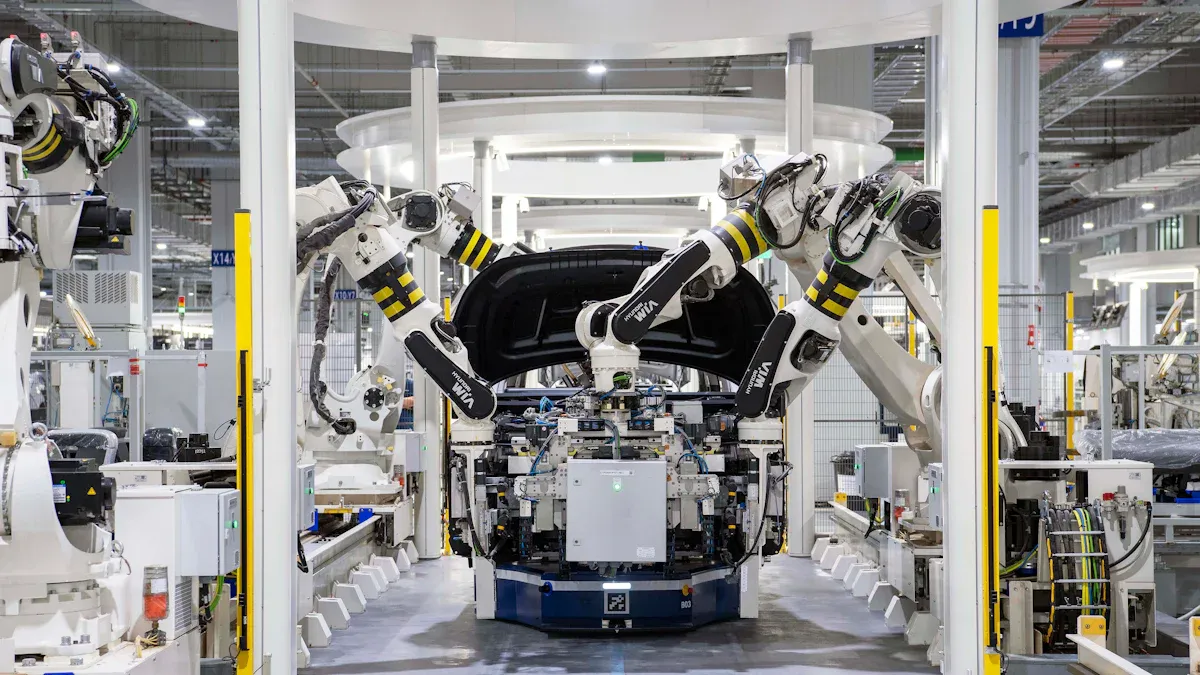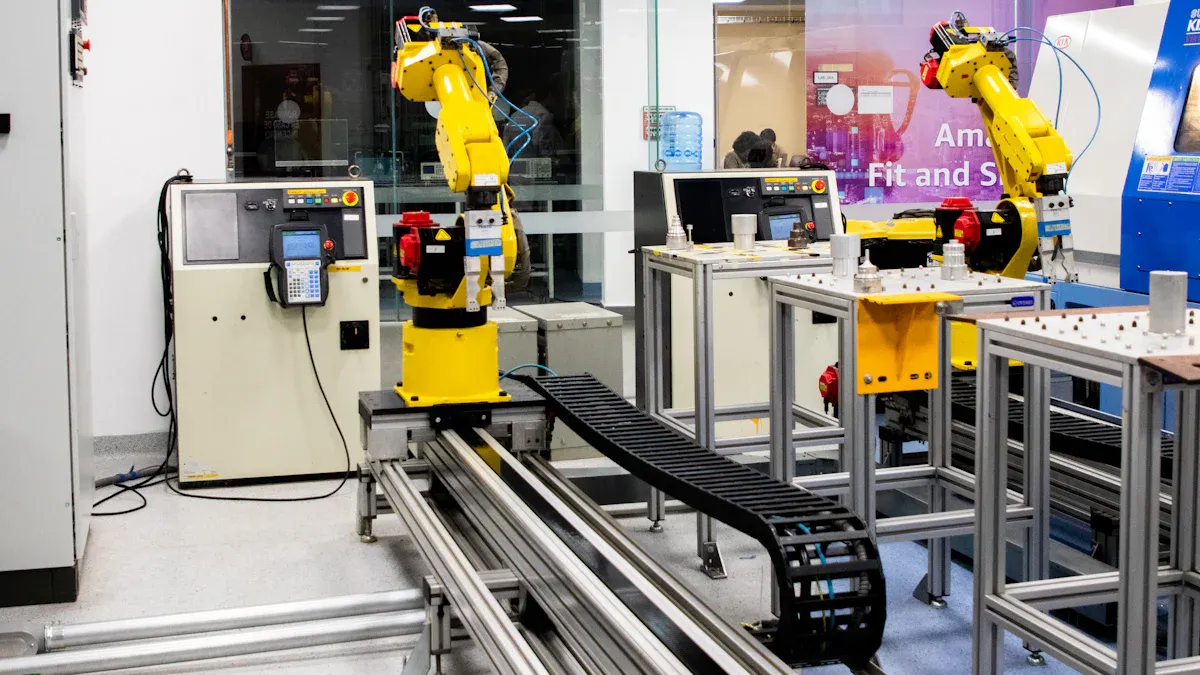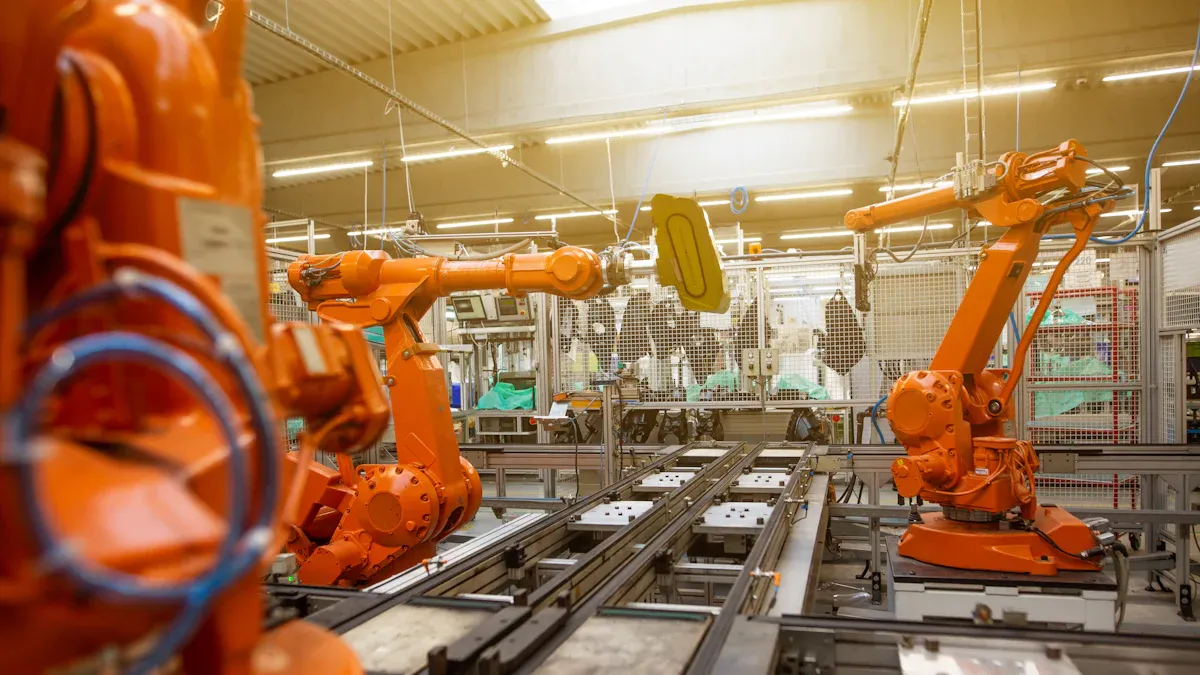Why Magnesium Alloys Are Revolutionizing Lightweight Manufacturing

Magnesium alloys are transforming how things are made today, highlighting the magnesium alloys importance in modern manufacturing. They are light yet strong, which improves efficiency. These materials are utilized in industries like automotive and aerospace, where weight is a critical factor. For instance, magnesium alloy gearboxes are 25% lighter than aluminum ones, demonstrating their ability to reduce weight while maintaining toughness. Additionally, they can be recycled easily, contributing to environmental sustainability. This aligns with global goals to protect the planet. The importance of magnesium alloys cannot be overstated, as they are not only effective but also eco-friendly, making them a key component of innovative manufacturing solutions.
Magnesium Alloys Importance and Unique Properties
Composition and properties of magnesium alloys
Magnesium alloys mix magnesium with metals like aluminum, zinc, and manganese. These mixtures improve their strength and other features, making them great for modern uses. For example, magnesium alloys are very light, with a density of about 1.8 g/cm³. This is much lighter than aluminum, which has a density of 2.8 g/cm³. Being lightweight is one reason they are so popular.
These alloys are also easy to shape and cut. They can be worked on quickly using less energy, which helps save time and power in factories. Plus, they resist rust, making them last longer even in tough conditions.
Property | Description |
|---|---|
Low Density | Magnesium alloys weigh less, with a density of 1.8 g/cm³, compared to aluminum's 2.8 g/cm³. |
Strength-to-Weight Ratio | They are as strong as some aluminum and steel but much lighter. |
Corrosion Resistance | They resist rust, which helps them last longer in harsh places. |
Excellent Machining Capabilities | They are easy to cut and shape, saving time and energy in factories. |
These features show why magnesium alloys are important for modern manufacturing and why they are perfect for making lightweight products.
High strength-to-weight ratio and corrosion resistance
Magnesium alloys are special because they are strong but still light. This makes them perfect for industries like cars and airplanes. For example, the Mg-11Y-1Al alloy is very strong, with a yield strength of 350 MPa and can stretch by 8% before breaking.
Another great feature is that they resist rust. The Mg-11Y-1Al alloy, for instance, rusts very slowly, at less than 0.2 mm per year. This makes it great for use in places where materials need to last a long time. Together, their strength and rust resistance make magnesium alloys reliable for many uses.
Comparison with aluminum, steel, and plastics
Magnesium alloys have clear advantages over other materials. For example, aluminum-magnesium alloys are 30% lighter than pure aluminum but just as strong. This makes them a top choice for lightweight designs.
Steel is strong but much heavier than magnesium. This extra weight can lower fuel efficiency in cars or reduce how much planes can carry. Plastics are light but not as strong or durable as magnesium alloys.
The AZXM2110 alloy shows how good magnesium alloys can be. It has a strength of 344 MPa and can stretch by 21.3% before breaking. A mix of 0.6% calcium, 0.4% manganese, 1% zinc, and 2% aluminum makes aluminum-magnesium alloys even better. These alloys are now a key part of modern manufacturing.
By being light, strong, and rust-resistant, magnesium alloys are better than many traditional materials for industrial uses.
Magnesium Alloys in Lightweight Manufacturing

Role in reducing weight without compromising strength
Magnesium alloys help make things lighter but still strong. They are used in transportation, where lightweight materials are very important. Magnesium is 30% lighter than aluminum, so it helps make lighter parts without losing strength. This is why it works well for cars, planes, and even spaceships.
Magnesium alloys are great for making light vehicle parts because they are strong and weigh less.
Scientists are finding better ways to use these alloys in cars, trains, planes, and space projects.
Using magnesium shows how manufacturing can reduce weight while staying safe and strong.
By using magnesium alloys, industries can make lighter products that work better and save energy.
Benefits for structural applications in engineering
Magnesium alloys are great for building strong and light structures. Their low weight and high strength make them useful in many areas. A new process called hard-plate rolling (HPR) makes magnesium alloys even stronger.
Magnesium alloys are perfect for making lightweight and strong parts. The HPR process improves the strength (371 MPa) and flexibility (23%) of Mg-9Al-1Zn (AZ91) plates. This makes magnesium alloys better for building strong structures.
This new method shows how magnesium alloys can meet modern engineering needs by being both strong and flexible.
Examples of lightweight designs in vehicles and electronics
Magnesium alloys have changed how vehicles and electronics are designed. For example, making a car 10% lighter can save 6-8% on fuel and cut emissions by 5-6%. Magnesium can make parts 50-75% lighter, which is a big deal for cars.
Magnesium alloys help electric cars go farther, which buyers like.
In electronics, magnesium is used for light cases in laptops, phones, and cameras.
These examples show how magnesium alloys improve designs, making them better and more eco-friendly.
Benefits of Magnesium Alloys in Modern Industries
Saving Energy by Reducing Weight
Magnesium alloys help save energy in cars and planes. They are light, which makes vehicles use less fuel. For example:
Cutting a car's weight by 10% saves 6-8% on fuel.
Cars use 5.6% less fuel, and trucks save 6.3% with less weight.
These changes also cut CO2 emissions, helping the environment. Smaller engines can be used with lighter vehicles, boosting fuel efficiency by 6.8%. Magnesium is strong and light, making it very useful today.
Lower Costs in Making and Shipping
Magnesium alloys save money in production and shipping. Lighter products cost less to transport because they need less energy. Magnesium is easy to work with, so factories use less power to make parts.
Benefit | Explanation |
|---|---|
Cheaper Production | Making magnesium uses less energy than other materials. |
Growing Demand | More industries want lightweight materials like magnesium. |
Saving Money | Lighter products mean lower fuel costs and better profits. |
In industries like car-making, magnesium alloys are affordable and effective. Electric cars use them to save money and improve performance.
Better for the Environment
Magnesium alloys are great for recycling, which helps the planet. Recycling magnesium uses much less energy than making new magnesium. Using magnesium instead of heavier materials also lowers CO2 emissions.
Magnesium alloys in cars save fuel and help the environment. A 10% weight cut means 6-8% less fuel use, which is good for the planet.
By using magnesium, industries can reduce waste and support recycling. Its light weight and recyclability make it a smart choice for eco-friendly manufacturing.
Applications of Magnesium Alloys Across Industries

Aerospace: Lightweight parts for planes and spaceships
Magnesium alloys are very important in aerospace. They are light and strong, which helps make planes and spaceships weigh less. For example, magnesium is 36% lighter than aluminum and 78% lighter than iron. This makes planes use less fuel and carry more weight. Magnesium alloys also resist rust, so they last longer in tough places like high altitudes or space.
Scientists at Pusan National University have created smart models to make magnesium alloys safer for aerospace. These models use computers to predict how long parts will last under stress. This helps ensure parts stay strong and safe for a long time. Magnesium alloys are now a key material in building planes and spaceships.
Industry | Benefits of Use |
|---|---|
Aerospace | Lightweight and strong materials improve fuel use and safety. |
Automotive: Lighter cars and better electric vehicles
Car makers use magnesium alloys to make cars lighter but still strong. Lighter cars need less fuel, which lowers pollution and saves energy. Studies show magnesium alloys can make car parts 22% to 70% lighter than other materials. A 10% lighter car uses 6-8% less fuel, saving money and helping the planet.
Magnesium alloys are also great for electric cars (EVs). Lighter materials help EVs go farther and work better. For example, aluminum-magnesium alloys are used in battery cases and car frames. These materials are strong and light, making engines smaller and more efficient. Magnesium alloys are helping create better and greener cars.
Industry | Benefits of Use |
|---|---|
Automotive | Lighter parts save fuel and reduce pollution. |
Electronics: Light cases for laptops and phones
Magnesium alloys have changed how electronics are made. They are light and strong, making them perfect for laptop, phone, and camera cases. Compared to aluminum or steel, magnesium alloys weigh less, making devices easier to carry and use.
The demand for magnesium alloys in electronics is growing fast. People want lighter devices that save energy and last longer. Magnesium cases also help cool devices by spreading heat better. This makes them a top choice for modern electronics.
Industry | Benefits of Use |
|---|---|
Electronics | Lightweight and durable materials improve device design. |
New Uses: Green Energy and Medical Tools
Magnesium alloys are changing green energy and medical tools. Their light weight and body-friendly features make them perfect for new ideas. These industries use magnesium alloys to create better, eco-friendly, and advanced products.
Green Energy: Helping the Planet
Magnesium alloys are important in solar panels and wind turbines. They are light, making parts easier to move and set up. For example, solar panel frames use magnesium alloys because they are strong and don’t rust. Wind turbine parts made with magnesium alloys are lighter, which helps them work better and save energy.
Using magnesium alloys makes green energy systems cheaper and better for the planet. This supports the global move to cleaner energy.
Medical Tools: Improving Health Technology
Magnesium alloys are changing medical tools because they are light and safe for the body. They are used in bone screws and plates that dissolve naturally in the body. This means no extra surgery is needed to take them out, helping patients heal faster. Magnesium alloys are also used in surgical tools, making them easier to handle and reducing tiredness for doctors.
Fitness trackers and smartwatches also use magnesium alloys. These materials make them strong, light, and comfy to wear for a long time.
Examples of Use
The table below shows how magnesium alloys are used in green energy and medical tools:
Use Area | Details |
|---|---|
Medical Tools | Used in bone implants, surgical tools, and other medical items because they are light and body-safe. |
Green Energy | Used in parts for solar panels and wind turbines to make them lighter and stronger. |
Wearable Devices | Used in fitness trackers and smartwatches for comfort and strength. |
These examples show how magnesium alloys help new industries grow. By using these materials, we can build a greener and smarter future.
Sustainability and Environmental Impact of Magnesium Alloys
Contribution to reduced carbon footprint
Magnesium alloys help industries lower their carbon footprint. Their light weight reduces fuel use in cars and planes, cutting harmful gas emissions. For example, magnesium alloy wheels are better for the environment than aluminum ones. They produce fewer carbon emissions over their lifetime, making them a greener choice.
The International Magnesium Association (IMA) found ways to cut emissions during magnesium production. The Pidgeon process, a common method, has reduced greenhouse gases since 2011. This supports global goals to lower CO2 emissions and promotes a circular economy.
Material Type | Weight (kg) | CO2 Emissions (kg CO2eq/kg) |
|---|---|---|
Magnesium (AM50) | 4 | |
Aluminum (AlMg3) | 5.4 | 1.4 |
Using magnesium alloys helps create a cleaner future and meet eco-friendly goals.
Recyclability and circular economy potential
Magnesium alloys are easy to recycle, making them great for a circular economy. Recycling uses less energy, about 2–3 kWh per kilogram, and emits under 1 kg of CO2 per kilogram. This makes recycling magnesium better for the planet.
Recycling is key to fighting climate change. Magnesium is important for green technologies like solar panels and electric cars. Advanced recycling systems ensure resources are reused and materials are not wasted.
Aspect | Details |
|---|---|
Recycling Process | Scrap is melted and reused with low energy. |
Greenhouse Gas Emissions | Less than 1 kg of CO2 per recycled kilogram. |
Recycling Rate | Over 50% of magnesium is lost to improper recycling. |
Supporting magnesium recycling helps reduce waste and protect the environment.
Challenges and solutions for sustainable production
Making magnesium alloys sustainably has challenges, like brittleness and oxygen impurities. These problems limit their use in some products. But new ideas are solving these issues.
A three-step design method is improving magnesium alloy production. This includes:
Thin film growth to study how materials form.
Quick alloy testing to connect structure with strength.
Property studies using large-scale metallurgy techniques.
These methods make magnesium alloys stronger and more useful. By using these solutions, industries can solve production problems and fully use magnesium alloys.
Future Trends and Advancements in Magnesium Alloys
New ideas in alloy makeup and processing methods
Magnesium alloys are changing how metals are made. Scientists are adding rare earth elements to aluminum-magnesium alloys. These changes make the alloys stronger and better at handling heat. They are perfect for tough jobs where materials need to last.
Ways to process magnesium are also improving fast. New methods now get magnesium from waste in eco-friendly ways. 3D printing is being used to make lightweight magnesium parts with strong designs.
Tip: Computers and AI are helping design better alloys. They predict how alloys resist rust and other problems, making development quicker and smarter.
Type of Improvement | What It Does |
|---|---|
Alloy Makeup | Rare earth elements make alloys stronger and heat-resistant. |
Processing Methods | Eco-friendly ways to get magnesium from waste materials. |
3D Printing | Creates light parts with strong designs. |
AI Technology | Predicts rust resistance for faster alloy design. |
These advancements are keeping magnesium alloys ahead in lightweight manufacturing.
New uses in green energy and medical tools
Magnesium alloys are helping in green energy and health tools. Solar panels use aluminum-magnesium alloys to weigh less and work better. Wind turbines last longer because magnesium is strong and doesn’t rust easily.
In medicine, magnesium alloys are changing surgical tools and implants. They dissolve in the body, so no extra surgery is needed to remove them. Fitness trackers and smartwatches use magnesium for light and strong cases, making them comfy to wear.
These examples show how magnesium alloys are improving industries that need eco-friendly and high-performing materials.
Studies shaping better magnesium alloys
Research is making magnesium alloys even better. Scientists use computers to guess how well alloys handle heat. They’ve studied over 1,100 heat tests to find important features like atom size and energy strength.
A computer program called XGBoost is very accurate, with only 2.16% error in its guesses. This helps create better materials for managing heat in lightweight designs.
Research Area | What It Found |
|---|---|
Focus of Study | Using computers to predict heat handling in alloys. |
Key Features | Atom size and energy strength are important. |
Program Accuracy | XGBoost guesses with only 2.16% error. |
Future Goals | Study more alloy elements and heat properties. |
This research is making sure magnesium alloys stay useful and better than older materials.
FAQ
Why are magnesium alloys better for lightweight manufacturing?
Magnesium alloys are lighter than aluminum and steel but still strong. They resist rust and can be recycled easily. This makes them great for cars, planes, and eco-friendly designs.
Can magnesium alloys be recycled?
Yes, magnesium alloys are easy to recycle. Recycling uses less energy than making new magnesium. This helps the environment and supports reusing materials.
Are magnesium alloys safe for medical use?
Magnesium alloys are safe for the body and dissolve naturally. They are used in implants like bone screws, which don’t need removal surgery. This makes them helpful for medical tools.
How do magnesium alloys help cars save fuel?
Magnesium alloys make cars lighter, cutting weight by up to 70%. Lighter cars use less fuel, saving energy and reducing pollution. They improve performance and help the planet.
Which industries use magnesium alloys the most?
Magnesium alloys are used in aerospace, cars, electronics, and green energy. They make planes lighter, cars more efficient, and devices stronger. They also help renewable energy systems work better.
See Also
Essential Trends Shaping the 2025 Aluminum Die Casting Industry
Enhancing Diecast Product Longevity Through Electroplating Techniques
Importance of Metal Substrates in Today’s Industrial Applications
Exploring Advantages of CAE Analysis for Die Casting Design
Navigating CBAM: A Sustainability Guide for Casting Suppliers
About Hunan Puka
Established in 2016 and based in Hunan, China, with a liaison point in Berlin, we are a Tier 2 supplier for the automobile industry. We specialize in the production of customized aluminum die-casting parts designed for machines with a closing force ranging from 280 to 1250 tons, with subsequent manufacturing process CNC machining and surface treatment. Our commitment to quality is reflected in our accredited quality management system, certified by ISO9001:2015 and IATF16949:2016 standards.


